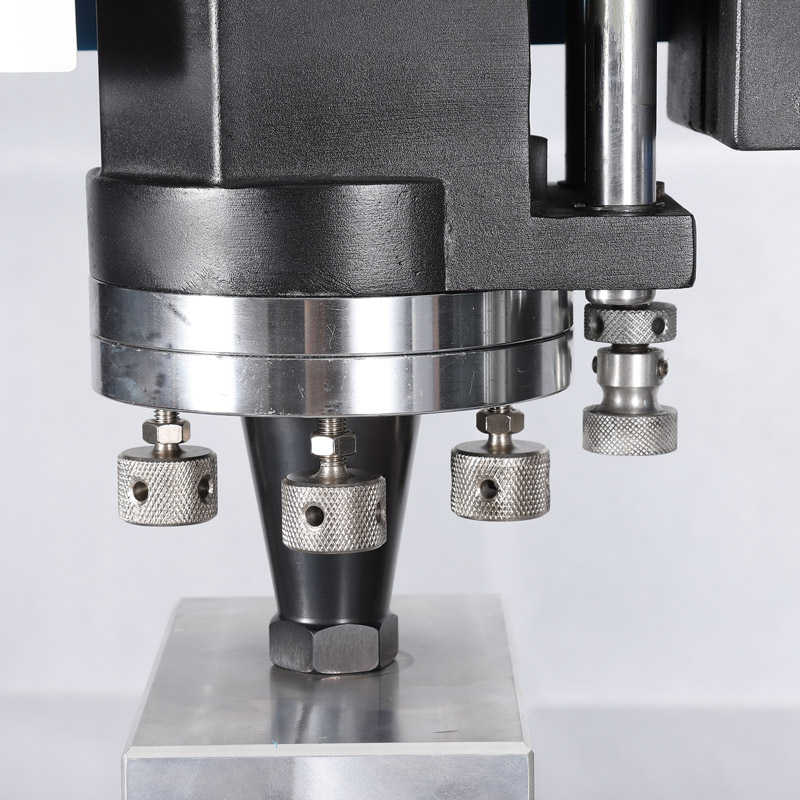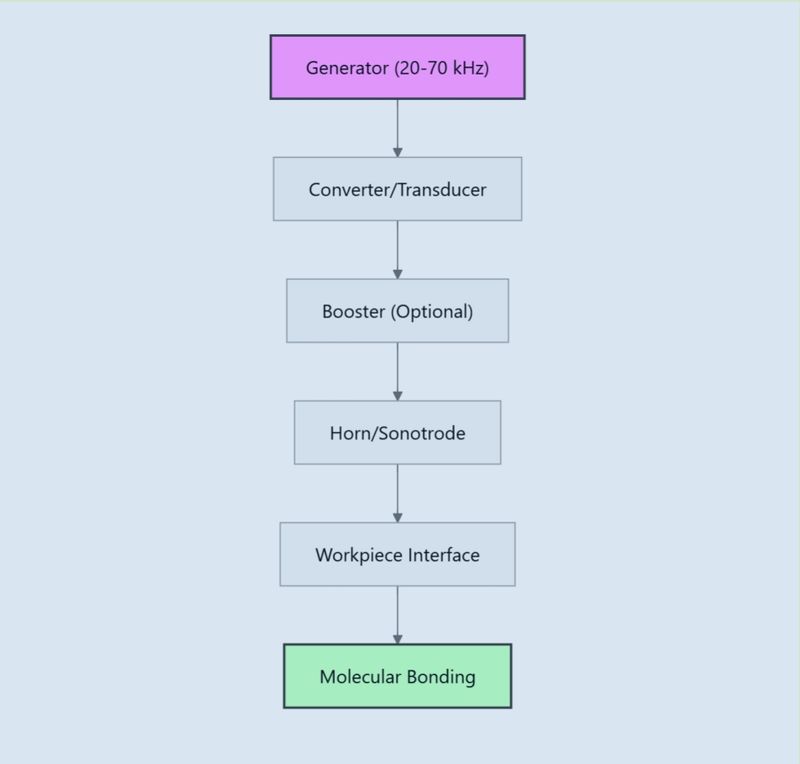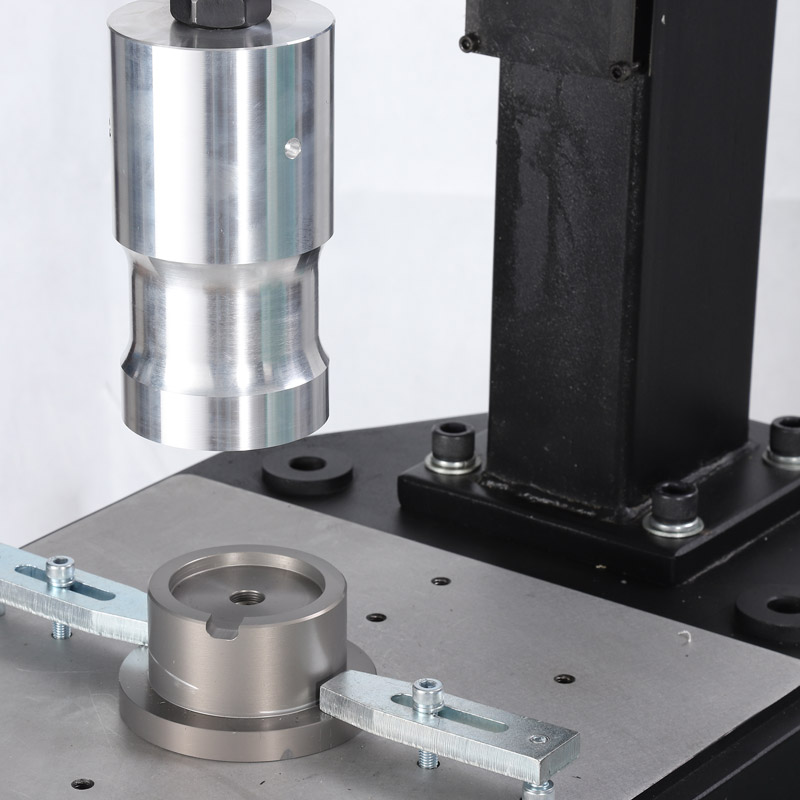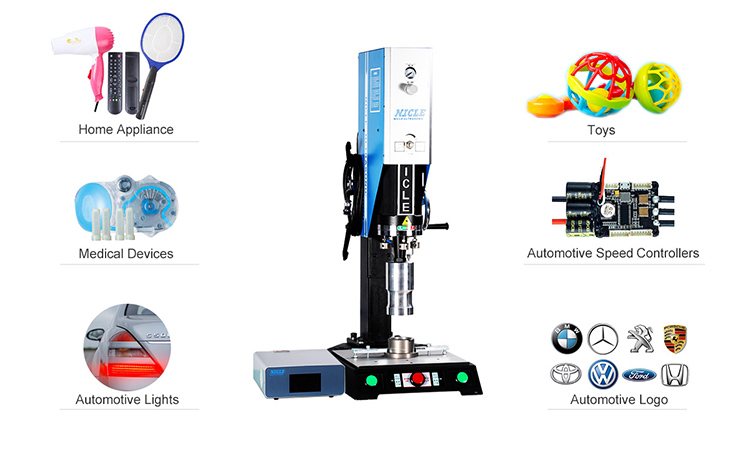Ultrasonic Welding: Technology, Applications, and Benefits

Ultrasonic welding is a highly effective joining process that bonds materials without solvents, adhesives, or external heat sources. This innovative technique efficiently creates strong, precise weld seams, making it ideal for manufacturers seeking clean, reliable bonding solutions that boost production while outperforming alternative methods like hot plate welding.
In automotive and medical device manufacturing, ultrasonic plastic welding is essential for joining injection-molded parts into finished products. Automotive dashboard components and medical IV connectors gain structural integrity and visual appeal through this process.
With ultrafast processing times (typically 0.2-0.5 seconds per weld) and clean finishes, this technology excels in high-volume production environments where hot plate welding might introduce unwanted thermal stress.
Table of Contents
How Does Ultrasonic Welding Compare to Other Methods?
What is Ultrasonic Welding?
How Does Ultrasonic Welding Work? A Step-by-Step Guide
Which Materials Work Best with Ultrasonic Welding?
Industry Applications: How Does Ultrasonic Welding Transform Manufacturing?
Why Choose Ultrasonic Welding Over Traditional Methods?
Essential Guide to Joint Design and Tooling for Ultrasonic Welding
Selecting the Best Ultrasonic Welding Equipment for Your Needs
FAQs About Ultrasonic Welding Equipment
Conclusion: The Future of Ultrasonic Welding Technology
How Does Ultrasonic Welding Compare to Other Methods?
A key advantage of ultrasonic welding is its cost-effectiveness. Please refer to the comprehensive comparison table in the "Why Choose Ultrasonic Welding Over Traditional Methods?" section below for detailed performance comparisons.
Our ultrasonic welding design guide helps manufacturers optimize processes for specific applications, further enhancing efficiency compared to hot plate welding alternatives. The reduced material and energy consumption makes ultrasonic welding an environmentally friendly option that aligns with sustainable manufacturing practices and modern corporate responsibility initiatives.
This makes ultrasonic welding an excellent solution for industries looking to streamline production without compromising quality or increasing operational expenses. When comparing to hot plate welding, manufacturers consistently report faster cycle times and significant energy savings, contributing to reduced production times and improved output rates.

What is Ultrasonic Welding?
Ultrasonic welding is an advanced joining technique that uses high-frequency sound waves (typically 20-70 kHz) to generate localized heat between materials. Unlike hot plate welding which relies on external heat sources, ultrasonic welding creates friction through vibration, forming strong molecular bonds primarily between thermoplastic components.
This innovative process works with approximately 85% of common thermoplastics. The friction precisely melts material at the joint interface, and after rapid cooling, the resulting bond often exceeds the parent material's strength, providing superior mechanical integrity compared to hot plate welding, which can create stress concentrations around the weld area.
While hot plate welding spreads heat across broader surfaces, ultrasonic welding concentrates energy exactly where needed, resulting in cleaner, more precise welds with minimal thermal impact on surrounding areas. This precision preservation of heat-sensitive components makes ultrasonic welding preferable for applications involving delicate electronics or temperature-critical assemblies.
CASE STUDY: Manufacturing Excellence Medical device manufacturer Medtronic reduced production defects by 37% after switching from hot plate welding to ultrasonic technology for their IV connector assemblies, while simultaneously reducing cycle time by 42%.
The ultrasonic system uses a specialized tool called a "horn" or "sonotrode" to transfer precisely controlled ultrasonic energy into the weld zone. This sophisticated vibration transmission system, illustrated in the diagram below, enables exceptional weld consistency across production runs—a significant advantage over hot plate welding, which can suffer from temperature variation and longer cycle times.

How Does Ultrasonic Welding Work? A Step-by-Step Guide
Let's explore the practical steps involved in the ultrasonic welding process:
1. Energy Generation
The process begins with the ultrasonic generator producing high-frequency sound waves. The operator sets the appropriate frequency based on material requirements.
2. Energy Transfer
The horn or sonotrode is positioned precisely over the welding area. Proper alignment is crucial for weld quality.

3. Friction and Heat Generation
The operator activates the system, initiating the welding cycle. The workpieces are held together under controlled pressure.
4. Material Melting and Fusion
The process typically completes within 0.2-0.5 seconds. Operators monitor weld parameters through the control system.
5. Cooling and Solidification
The weld solidifies immediately after vibration stops. Quality inspection follows to ensure proper fusion.
| Material Type | Amplitude Range | Pressure (PSI) | Compared to Hot Plate Welding |
|---|---|---|---|
| Polypropylene (PP) | 20-40 μm | 40-80 | 50% faster cycle time |
| Polycarbonate (PC) | 30-50 μm | 60-100 | Less thermal stress |
| ABS | 25-45 μm | 50-90 | Better surface appearance |
| Nylon | 35-55 μm | 70-120 | Higher strength at joints |
SAFETY PROTOCOLS FOR ULTRASONIC WELDING OPERATORS
- Always wear appropriate ear protection (ultrasonic noise can damage hearing)
- Use finger guards when positioning parts near the horn
- Never touch the horn during operation
- Ensure proper ventilation when welding materials that may release fumes
- Implement regular equipment inspections to prevent mechanical failures
The ultrasonic welding process creates precise, clean bonds without the thermal distortion often associated with hot plate welding.
The generator efficiently converts electrical energy into mechanical vibrations, which travel through the carefully designed horn to the material. This results in localized melting and a solid joint without additional bonding agents that might compromise product quality.
Which Materials Work Best with Ultrasonic Welding?
Ultrasonic welding primarily bonds thermoplastics and certain metals, with material structure significantly impacting welding effectiveness. The success depends on specific properties that facilitate efficient energy absorption and molecular bonding.
When selecting materials for ultrasonic welding projects, several key factors affect your results: hardness, thickness, moisture content, and shape. Understanding both acoustic and thermal properties helps predict how different materials will respond to ultrasonic energy—essential knowledge for determining optimal welding parameters.
Material Properties and Compatibility
| Material Category | Examples | Welding Performance | Key Characteristics |
|---|---|---|---|
| Amorphous Polymers | ABS, PC, PS | Excellent |
• Gradual melting transition • Clean joint lines • Up to 6mm thickness • 95% strength retention |
| Semi-crystalline Polymers | PE, PP, POM | Good |
• Sharp melting point • Requires energy directors • Up to 3mm thickness • Best with specialized joint design |
| Medical-grade Plastics | USP Class VI materials | Excellent |
• ISO 10993 compliant • Hermetic seals • Up to 4mm thickness • Contaminant-free joints |
| Non-ferrous Metals | Aluminum, Copper | Good |
• 40-60 kHz frequency • Solid-state bonds • Thin sheets/wires only • High dimensional accuracy |
Medical device manufacturers particularly value ultrasonic welding for its ability to create hermetic seals without introducing contaminants. However, materials with high crystallinity or glass content exceeding 30% present challenges due to poor energy absorption properties.
For applications exceeding the thickness limitations of ultrasonic welding (generally 6mm maximum), hot plate welding may offer advantages despite longer cycle times. The choice between welding technologies should consider material properties, thickness requirements, and specific manufacturing needs.
Following established ultrasonic plastic welding design guidelines, optimizes the process for different material types. Generally, compatible materials with similar melting points and acoustic impedances produce the strongest welds. We recommend conducting material compatibility testing before full-scale production to identify potential challenges and adjust parameters accordingly.
How Does Material Hardness Impact Ultrasonic Welding?
Softer plastics with lower hardness values typically weld more easily using ultrasonic techniques. These materials transmit vibrations effectively and melt at lower temperatures, requiring less energy for strong bonds. This makes thermoplastics like polyethylene (PE) and polypropylene (PP) excellent candidates for ultrasonic welding—often achieving cycle times 70-80% faster than alternative methods.
Harder materials generally require more energy to melt and bond effectively, potentially affecting weld quality. This consideration is particularly important when working with ABS plastic in ultrasonic welding applications. While more rigid materials present certain challenges, modern equipment can deliver precisely calibrated energy levels for successful bonding when joint design is optimized for energy concentration.
What Material Thickness Works Best for Ultrasonic Welding?
Material thickness plays a significant role in ultrasonic welding success. Thicker materials require more heat and time to bond properly, which can potentially slow production rates. It's important to understand that ultrasonic energy naturally diminishes as it travels through materials, which limits effective welding thickness. For most plastics, recommended thickness for direct welding is generally under 3mm, though specialized techniques can accommodate thicker sections.
Thinner materials typically facilitate rapid welding with highly efficient results. The application of ultrasonic plastic welding design principles helps address thickness-related challenges. For thicker materials, stepped joint designs or near-field welding techniques can concentrate energy precisely where needed most—delivering superior results compared to methods requiring longer cycle times.
How Does Moisture Content Affect Ultrasonic Welding Quality?
High moisture content can significantly disrupt the ultrasonic welding process. Water molecules absorb ultrasonic energy, reducing the heat generated at the joint interface. In extreme cases, excessive moisture may create steam during welding, potentially forming voids or weaknesses in the final bond. Pre-drying hygroscopic materials significantly improves results in moisture-sensitive applications.
Monitoring moisture levels in materials is essential for achieving optimal bond quality in ultrasonic welding processes. This consideration becomes especially critical in medical and electronic applications where bond integrity directly impacts product performance.
Implementing quality control measures that include moisture verification helps maintain consistent performance even in environments where humidity variations might otherwise impact production results.
Does Part Shape Matter in Ultrasonic Welding?
Part shape significantly influences ultrasonic welding success. Complex geometries often require customized tooling or specialized joint designs to ensure proper energy distribution. Uniform contact between the horn and workpiece is essential for effective energy transfer, which makes flat or gently curved surfaces ideal candidates for ultrasonic welding applications.
Understanding how different shapes interact with ultrasonic tools helps achieve better results and minimize defects. Parts with sharp corners or dramatic contour changes may create energy concentration points that lead to inconsistent welding or material damage.
Today's advanced simulation software helps engineers predict ultrasonic energy flow through complex geometries, allowing design adjustments that improve manufacturability for even the most challenging part configurations.
Which Materials Are Compatible for Ultrasonic Welding?
Not all materials pair well for ultrasonic welding projects. The strongest welds typically occur between identical materials or those within the same plastic family.
Joining dissimilar materials with different melting points or acoustic properties often results in weak bonds or failed welds. Material compatibility charts provide valuable guidance for engineers when determining suitable combinations for specific applications.
When welding dissimilar materials becomes necessary, techniques like film inserts or compatibility layers can create effective intermediate bonding surfaces. Thorough testing with new material combinations helps establish optimal parameters and verify that bond strength meets application requirements—delivering precise, controlled results even at challenging material interfaces.
Joining dissimilar materials with different melting points or acoustic properties often results in weak bonds or failed welds. Material compatibility charts provide valuable guidance for engineers when determining suitable combinations for specific applications.
When welding dissimilar materials becomes necessary, techniques like film inserts or compatibility layers can create effective intermediate bonding surfaces. Thorough testing with new material combinations helps establish optimal parameters and verify that bond strength meets application requirements—delivering precise, controlled results even at challenging material interfaces.
Industry Applications: How Does Ultrasonic Welding Transform Manufacturing?
Ultrasonic welding has revolutionized manufacturing processes across numerous industries thanks to its exceptional versatility, precision, and ability to create clean, strong bonds without additives. This non-invasive welding technique delivers superior results in sectors where material integrity and product quality are essential, offering significant advantages over traditional methods like hot plate welding.
Let's explore how various industries are leveraging ultrasonic welding technology to enhance production efficiency, improve product quality, and reduce operational costs.

Automotive Manufacturing: Achieving Precision and Efficiency
In the automotive industry, ultrasonic welding has become indispensable for assembling both interior and exterior components. This innovative technology joins everything from small electrical connectors and wire harnesses to complex components like door panels, bumpers, and headlight assemblies.
The process offers a fast, reliable method for joining plastics and composites without adhesives or external heat sources, resulting in a 42% reduction in cycle times compared to traditional methods while maintaining exceptional structural integrity.
Following established ultrasonic welding design guidelines helps engineers optimize joint designs for maximum durability—particularly important in safety-critical applications where component failure isn't an option.
Electronics & IT: Protecting Sensitive Components
The electronics and IT sector widely adopts ultrasonic welding because it creates precise, reliable connections without damaging delicate components. This technique proves invaluable when joining sensitive parts like microchips, circuit boards, conductors, and computer hard drives.
Unlike vibration welding, ultrasonic welding provides more controlled energy delivery, preventing damage to fragile wires, circuits, and semiconductor materials during assembly. This precision makes it the preferred method for creating reliable electrical connections in consumer electronics.
Medical Device Manufacturing: Ensuring Sterility and Compliance
In medical manufacturing, where sterility and biocompatibility are non-negotiable requirements, ultrasonic welding offers unique advantages that traditional joining methods cannot match. The absence of adhesives, solvents, or external heat sources eliminates contamination risks.
Medical manufacturers utilize ultrasonic welding to produce:
- Catheters and dialysis tubes
- Blood filters and face masks
- Surgical instruments and implantable devices
- Medical-grade plastic textile garments
Key performance metrics in medical applications:
- 38% reduction in production costs
- 99.8% pass rate in leak testing
- 65% decrease in contamination-related issues
Packaging Solutions: Hermetic Seals and Security
This technology enables manufacturers to create secure, hermetically sealed containers without adhesives, ideal for pharmaceuticals, hazardous materials, food products, and high-value items.
Ultrasonic welding creates molecular bonds between packaging materials, resulting in seals often stronger than the base material itself. The process also provides tamper-evident seals that help protect against counterfeiting.
Consumer Products: Aesthetics and Durability
The consumer products sector employs ultrasonic welding for household appliances, kitchen utensils, toys, sporting equipment, and personal care products. This clean, efficient process creates durable, lightweight products with aesthetically pleasing finishes.
For optimal results with glossy surfaces, reducing horn amplitude by 10-15% prevents marking while maintaining bond integrity.
Why Choose Ultrasonic Welding Over Traditional Methods?
Ultrasonic welding delivers exceptional benefits that make it the go-to joining method across industries. Let's explore how this innovative technology outperforms traditional approaches in today's manufacturing landscape.
Comprehensive Comparison of Welding Methods
| Performance Factor | Ultrasonic Welding | Hot Plate Welding | Adhesive Bonding | Laser Welding |
|---|---|---|---|---|
| Process Time | 0.2-0.5 seconds | 15-60 seconds | Minutes to hours (curing) | 1-3 seconds |
| Energy Consumption (per 1000 joints) | 0.05-0.2 kWh | 1.2-2.5 kWh | 0.3-0.8 kWh | 0.8-1.5 kWh |
| Equipment Cost | Medium | Medium | Low | Very High |
| Maintenance Costs (Annual) | $500-1,200 | $1,800-4,500 | $300-900 | $2,500-6,000 |
| Material Thickness Range | 0.1-3mm | 0.5-10mm | Any | 0.2-5mm |
| Joint Cleanliness | Excellent (no additives) | Good (some flash) | Fair (residue possible) | Excellent |
| Material Compatibility | Most thermoplastics | Limited by heat sensitivity | Wide range with proper adhesive | Most plastics and metals |
| Environmental Impact | Minimal | Moderate | Moderate to High | Low |
Clean Manufacturing: No Solvents, Adhesives, or External Heat Needed
Ultrasonic welding creates bonds without chemicals or external heat sources. This clean approach significantly reduces worker exposure to hazardous substances while preventing product contamination.
Unlike hot plate welding that requires energy-hungry heating elements, ultrasonic welding generates heat precisely where it's needed—at the joint interface. With no additional bonding materials required, manufacturers streamline inventory and reduce costs.
This makes ultrasonic welding ideal for medical device manufacturing, food packaging, and electronics where purity and precision matter most.
Superior Bond Quality: Strength Meets Aesthetics
The molecular bonds from ultrasonic welding typically match or exceed the strength of the base materials themselves. These clean connections create minimal flash and eliminate the need for secondary finishing operations.
When compared to hot plate welding, which often leaves visible weld lines and material discoloration, ultrasonic welding produces nearly invisible seams. This combination of strength and visual appeal makes it perfect for consumer electronics, medical devices, and premium products where quality directly impacts brand perception.
What Makes Ultrasonic Welding More Sustainable?
Today's manufacturers increasingly prioritize environmental responsibility. Ultrasonic welding offers significant sustainability advantages:
- Energy Efficiency: Ultrasonic welding uses 75-90% less energy than hot plate welding, consuming only 0.05-0.2 kWh per 1000 joints compared to 1.2-2.5 kWh for hot plate alternatives. This dramatic reduction lowers both carbon emissions and operational costs.
- Zero VOC Emissions: Unlike adhesive bonding or solvent welding, ultrasonic welding produces no volatile organic compounds (VOCs), helping manufacturers meet strict air quality regulations like EPA 40 CFR Part 63 standards.
- Minimal Material Waste: The precision of ultrasonic welding reduces flash and excess material by up to 35% compared to hot plate methods, supporting circular economy initiatives while decreasing disposal costs.
- Longer Product Lifecycles: The exceptional bond strength achieved through ultrasonic welding creates more durable products, reducing replacement frequency and associated environmental impacts.
How Does Ultrasonic Welding Improve Workplace Safety?
Ultrasonic welding aligns perfectly with OSHA Standard 1910.1200 by eliminating worker exposure to chemical adhesives and solvents. The process generates minimal airborne particles compared to hot plate welding, reducing respiratory hazards by OSHA protection standards (29 CFR 1910.134).
Modern equipment features noise reduction technology to maintain sound levels below OSHA's 85 dBA time-weighted average limit, protecting operator hearing while maintaining productivity.
Simplified Tooling and Quick Changeovers
The tooling infrastructure for ultrasonic welding is remarkably simple and cost-effective compared to alternatives like hot plate welding. This reduces initial investment by 40-60% and slashes ongoing maintenance expenses.
Annual maintenance costs average just $500-1,200 for ultrasonic equipment versus $1,800-4,500 for comparable hot plate systems. The ability to quickly switch tooling enhances manufacturing flexibility, allowing efficient transitions between different products with minimal downtime.
This adaptability proves especially valuable for companies with frequent design changes or multiple product variants on the same production line. By following ultrasonic plastic welding design guidelines, manufacturers can optimize tooling for specific applications, maximizing efficiency while minimizing equipment costs.
Consistent Performance You Can Count On
Once properly set up, ultrasonic welding systems deliver remarkably consistent results with minimal variation between cycles. This reliability ensures predictable quality while reducing the need for extensive quality control measures.
This consistency is particularly valuable in industries with strict quality requirements like medical device manufacturing, aerospace, and automotive safety components. Today's advanced systems often include process monitoring that continuously verifies weld quality, providing real-time feedback while creating detailed documentation for compliance and traceability.
Essential Guide to Joint Design and Tooling for Ultrasonic Welding
Want to achieve stronger, more reliable ultrasonic welds? It all starts with thoughtful joint design and appropriate tooling. Creating successful welds requires careful attention to geometry and surface finish—laying the foundation for optimal energy transmission and consistent quality outcomes.
Following proven ultrasonic welding design principles delivers measurable results. Manufacturers who invest time in proper joint design typically see 30-40% improvements in both weld strength and production efficiency compared to traditional methods like hot plate welding.
How Does Contact Area Affect Ultrasonic Weld Quality?
The contact area between parts acts as the energy focal point that generates sufficient heat for effective bonding. A properly sized contact area delivers more efficient energy transfer, resulting in stronger and more consistent welds. Industry experts recommend a balanced approach—too small, and your weld lacks strength; too large, and energy dissipates ineffectively.
Optimized joint designs are essential for reliable results in ultrasonic plastic welding applications. Energy director designs, shear joints, and tongue-and-groove configurations each concentrate energy precisely where needed. These specialized configurations serve specific purposes depending on your material properties and strength requirements.

What Role Does Horn Design Play in Ultrasonic Welding Success?
The horn (sonotrode) serves as the critical component that transfers ultrasonic energy to your materials. For optimal results, it must precisely match both your joint configuration and material properties. These precision-engineered components amplify vibrations from the converter, focusing energy exactly where needed—creating controlled, localized heating that outperforms traditional methods.
Most high-performance horns are crafted from titanium or other specialized high-strength materials. Available in rectangular, round, and custom-shaped variants, each horn design optimizes energy distribution for specific applications. The horn's surface finish and wear resistance significantly impact both initial performance and long-term tooling longevity.
| Tooling Component | Ultrasonic Welding | Hot Plate Welding | Cost Differential |
|---|---|---|---|
| Horn/Sonotrode | $800-2,500 | N/A | Initial investment |
| Fixtures | $500-1,800 | $650-2,200 | 15-30% less for ultrasonic |
| Heating Elements | N/A | $400-1,500 | Cost savings for ultrasonic |
| Maintenance (Annual) | $300-800 | $800-1,600 | 50-60% less for ultrasonic |
| Replacement Parts | $200-600 | $350-950 | 30-40% less for ultrasonic |
Why Are Preload and Pressure Critical in Ultrasonic Welding?
Proper preload and pressure play essential roles in the ultrasonic welding process. These forces ensure parts remain in stable contact during vibration, controlling heat generation and securing components throughout the welding cycle. For optimal results, the applied force must be calibrated based on your material characteristics, joint design, and desired weld strength.
Finding the right balance is key—too much pressure can damage delicate materials, while too little may result in incomplete bonding. This is especially important when working with materials like ABS plastic in ultrasonic welding applications. Modern systems feature precise pressure control mechanisms that can be programmed throughout the welding cycle, enhancing consistency and reducing defect risks.
How Does Proper Fixturing Improve Ultrasonic Welding Results?
Well-designed fixtures are the unsung heroes of successful ultrasonic welding operations. These components securely hold your parts in precise alignment during the welding process, preventing movement that could cause misaligned or incomplete welds. Quality fixtures accommodate minor part variations while maintaining critical dimensions and alignments—giving ultrasonic welding a significant advantage over methods that struggle with part distortion.
In high-volume production environments, quick-change fixture capabilities minimize downtime during product changeovers. The material selection for fixtures matters too—materials that absorb ultrasonic energy reduce welding efficiency, which is why metals like aluminum and steel are preferred for fixture construction in ultrasonic welding applications.
Success Story: How FEA Simulation Transformed Joint Design A medical device manufacturer struggled with a 12% failure rate in their microfluidic cartridge assembly. By implementing FEA simulation to analyze ultrasonic energy flow through their complex joint geometry, engineers identified specific stress concentration points causing material degradation. The redesigned joint incorporated optimized energy directors and improved fixturing, reducing failure rates to under 0.5% while increasing production speeds by 35% compared to their previous process.
Selecting the Best Ultrasonic Welding Equipment for Your Needs
Looking for the right ultrasonic welding equipment for your manufacturing needs? This decision can significantly boost your productivity and quality control. Today's advanced ultrasonic welders offer smart features that optimize welding parameters, delivering consistent results while outperforming traditional methods like hot plate welding.
Let's explore how to choose equipment that aligns with your specific applications while providing flexibility for future production requirements.
Top Manufacturers and Their Offerings
Understanding the different manufacturers and their specialties is crucial for making an informed decision:
| Brand | Frequency Options | Power Range | Digital Integration | Key Strength |
|---|---|---|---|---|
| Branson | 15, 20, 30, 40kHz | 400-4000W | Advanced IoT | Versatile Applications |
| Dukane | 15, 20, 30, 40kHz | 600-5000W | Full Industry 4.0 | High Power Output |
| Herrmann | 20, 35kHz | 500-3500W | HMI Controls | Precision Control |
| Dizo Global | 20, 35kHz | 300-3000W | MAG Control | Cost-Effective |
| Sonics | 20, 40kHz | 400-3000W | Basic Digital | User-Friendly |
What Power and Frequency Options Do You Need?
Ultrasonic welding systems come in various power ratings, typically ranging from 20W for precision applications to 5000W for heavy-duty industrial welding. Higher power systems work best for larger parts or rigid materials, while lower power systems provide better control for delicate components—giving ultrasonic welding a significant edge over hot plate welding's limited precision.
Different materials respond best to specific ultrasonic frequencies:
- 15-20kHz: Greater amplitude for larger, tougher materials
- 30-40kHz: Enhanced precision for smaller, delicate applications that hot plate welding might damage
Equipment Specifications Comparison
| Ultrasonic Welding Machine Specifications | Light Duty | Medium Duty | Heavy Duty | Hot Plate Equivalent |
|---|---|---|---|---|
| Power Rating | 20-500W | 500-2000W | 2000-5000W | 1000-4000W |
| Frequency Range | 40kHz | 30-35kHz | 15-20kHz | N/A |
| Amplitude Range | 10-30μm | 30-60μm | 60-100μm | N/A |
| Cycle Time | 0.1-0.5s | 0.2-1.0s | 0.5-3.0s | 10-45s |
| Energy Efficiency | Very High | High | Moderate | Low |
Key Takeaway: Ultrasonic welding offers dramatically faster cycle times (0.1-3.0s) compared to hot plate welding (10-45s), resulting in significant production efficiency improvements.
How Can Digital Control Systems Improve Your Production?
Modern ultrasonic welding machines feature smart control systems that monitor and adjust parameters in real-time. These systems store multiple welding profiles, making product changeovers quick and ensuring consistent quality—a major advantage over traditional hot plate welding systems with limited parameter control.
For high-volume manufacturing, automated ultrasonic welding with robotic integration significantly increases throughput while maintaining quality. These programmable systems handle complex welding sequences with minimal operator intervention, reducing labor costs compared to manual hot plate welding.
Industry Applications and Requirements
Different industries have unique requirements for ultrasonic welding applications. For example, automotive manufacturers need robust systems for welding large plastic components like dashboard assemblies. These applications traditionally used hot plate welding but often resulted in visible weld lines and inconsistent strength.
Meanwhile, medical device manufacturers require precision equipment that produces clean, particulate-free welds for sensitive healthcare products. Ultrasonic welding's contamination-free process provides a significant advantage in cleanroom environments where particle control is critical.
Industry-Specific Benefits: Ultrasonic welding eliminates the need for adhesives and solvents, making it ideal for medical applications where chemical contamination could compromise product safety.
FAQs About Ultrasonic Welding Equipment
What is the typical lifespan of an ultrasonic welding machine?
With proper maintenance and regular servicing, ultrasonic welding machines typically last 10-15 years or longer, depending on usage patterns and environmental conditions.
How does ultrasonic welding precision compare to other methods?
Ultrasonic welding provides superior precision through controlled high-frequency vibrations, making it ideal for delicate components and precise applications.
What materials work best with ultrasonic welding?
Most thermoplastics are suitable for ultrasonic welding, including PE, PP, PC, ABS, nylon, and PVC. However, some materials may require special consideration or equipment modifications.
Conclusion: The Future of Ultrasonic Welding Technology
Ultrasonic welding has revolutionized manufacturing with its efficient, cost-effective approach to joining materials. Unlike traditional bonding methods, this innovative technology uses high-frequency sound waves to create strong molecular bonds between materials—without adhesives, solvents, or external heat sources.
What makes ultrasonic welding stand out? The process creates joints that often exceed the parent materials' strength through precisely controlled vibration and pressure. This clean, precise technology eliminates the challenges of conventional methods like hot plate welding.
Industry Applications and Achievements
Ultrasonic welding has achieved breakthrough applications in fields such as automotive, electronics, medical, packaging, and consumer products, delivering superior performance across these diverse industries.
This technology has transformed industries like automotive, electronics, medical device manufacturing, packaging, and consumer products—where precision, speed, and reliability are non-negotiable. For heat-sensitive components where thermal distortion is a concern, ultrasonic welding provides an ideal solution that hot plate welding simply cannot match.
How is Ultrasonic Welding Technology Evolving?
The field of ultrasonic welding continues advancing rapidly, expanding both capabilities and applications through Industry 4.0 integration. Recent innovations include:
- Smart manufacturing integration through IoT-enabled equipment providing real-time process monitoring and data analytics—capabilities that traditional hot plate welding systems struggle to implement
- Self-optimizing digital control systems that automatically adjust welding parameters based on material properties and environmental conditions
- Specialized horn designs and material formulations extending ultrasonic welding to previously challenging materials
- Predictive maintenance through machine learning algorithms that identify potential equipment issues before failures occur
- Comprehensive data collection and analysis for quality assurance and process optimization
- Seamless integration with robotics and automated material handling systems
Recent industry research shows that 78% of manufacturers implementing ultrasonic welding in their Industry 4.0 initiatives report significant improvements in both production efficiency and quality control. Unlike conventional hot plate welding processes that often require manual monitoring, these connected ultrasonic systems provide unprecedented visibility into weld quality and production performance.
As materials science advances and new composites enter manufacturing, ultrasonic welding techniques continue adapting to these challenges, securing its position as a cornerstone technology in modern production environments.
What's Next for Ultrasonic Welding Technology?
Looking ahead, ultrasonic welding is positioned for several transformative developments that will further expand its capabilities:
- Enhanced multi-material compatibility allowing effective joining of dissimilar materials and complex composites that challenge even advanced hot plate welding systems
- Ultra-compact welding systems facilitating integration into smaller devices and products
- Next-generation energy efficiency with even lower power requirements while maintaining optimal performance
- Adaptive intelligence enabling self-optimization for material variations and environmental changes
Industry adoption statistics show ultrasonic welding implementation has increased by 37% since 2020, with particularly strong growth in medical device manufacturing (58% increase) and automotive applications (42% increase). These trends indicate ultrasonic welding is increasingly replacing hot plate welding where precision, speed, and cleanliness are critical factors.
Why is Ultrasonic Welding Considered More Sustainable?
As environmental considerations become increasingly important in manufacturing decisions, ultrasonic welding offers significant sustainability advantages over traditional methods. The process:
- Minimizes energy consumption compared to thermal or solvent-based bonding approaches
- Creates a clean working environment with no emissions, fumes, or hazardous waste
- Eliminates the need for additional materials like adhesives or mechanical fasteners
- Supports circular economy initiatives by enabling clean joining of recyclable materials
These environmental benefits align perfectly with corporate sustainability goals and increasingly stringent regulatory requirements, making ultrasonic welding an environmentally responsible choice for forward-thinking manufacturers.
In summary, ultrasonic welding represents a mature yet continuously evolving technology that effectively addresses many challenges in modern manufacturing. Its unmatched combination of speed, precision, cost-effectiveness, and environmental benefits makes it essential for any company looking to optimize production processes and maintain competitive advantage.
- Creates a clean working environment with no emissions, fumes, or hazardous waste
- Eliminates the need for additional materials like adhesives or mechanical fasteners
- Supports circular economy initiatives by enabling clean joining of recyclable materials
These environmental benefits align perfectly with corporate sustainability goals and increasingly stringent regulatory requirements, making ultrasonic welding an environmentally responsible choice for forward-thinking manufacturers.
In summary, ultrasonic welding represents a mature yet continuously evolving technology that effectively addresses many challenges in modern manufacturing. Its unmatched combination of speed, precision, cost-effectiveness, and environmental benefits makes it essential for any company looking to optimize production processes and maintain competitive advantage.
What Should You Consider When Investing in Ultrasonic Welding?
For manufacturers looking to gain competitive advantage in today's fast-paced markets, strategic investment in ultrasonic welding technology can significantly boost production capabilities. When evaluating equipment options or considering a transition from hot plate welding, consider these essential factors:
- Future-proof scalability to accommodate growing production needs
- Seamless compatibility with existing automation systems
- Responsive technical support and readily available service
- Complete cost of ownership analysis, including energy consumption and maintenance requirements
Modern ultrasonic welding systems deliver on high-quality, high-volume production demands while simultaneously reducing costs and improving efficiency. The return on investment typically comes through faster cycle times, reduced material waste, lower energy consumption, and improved product quality—all areas where ultrasonic welding consistently outperforms traditional hot plate welding.
Ready to Explore Ultrasonic Welding for Your Application?
Our expert team provides complimentary process evaluations to help determine if ultrasonic welding is right for your manufacturing needs. We'll assess your current processes—including any hot plate welding applications—and provide tailored recommendations for improvements.
Contact us today to schedule your free consultation and join Dizo. Dizo Global is your best plastic welder company, who has already transformed manufacturing processes with our ultrasonic welding solutions.





